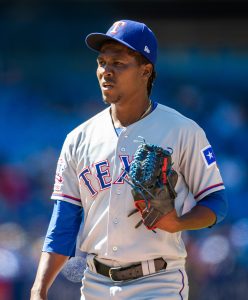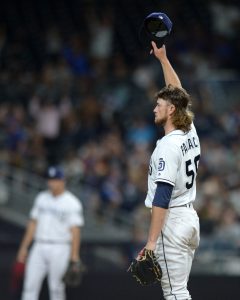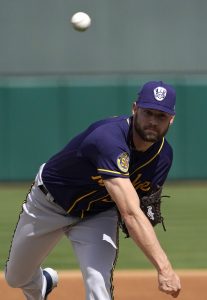In recent days, we’ve run through the most notable catchers, second basemen, shortstops, first basemen, third basemen, center fielders, and corner outfielders who are slated to reach the free-agent market once the offseason rolls around in several months. Now we’ll turn to the pitchers, beginning with southpaw relievers (players’ ages for the 2021 campaign are listed in parentheses).
Top of the Class
- Sean Doolittle (34): There’s no denying the 2019 downturn for a pitcher that had been among the game’s most dominant relievers for several years beforehand. His swinging-strike rate moved from 16.8% in the prior season down to 12.1%; his ERA shot up from 1.60 to 4.05. But most of the rough outings took place in the month of August, while Doolittle battled through a knee injury that ultimately forced him to the injured list. He returned to perform well late in the season and in the Nats’ World Series run (2 earned runs on 6 hits with 8:1 K/BB in 10 1/3 innings).
- Brad Hand (31): The Indians closer would surely be the top southpaw on this year’s class, but he’s not going to make it to market unless he has a disappointing season. With a typical campaign, the club is sure to pick up its $10MM club option rather than paying a $1MM buyout — though we could still see Hand moved via trade in that event.
Solid Setup Options
- Jose Alvarez (32): Not much jumps off the page here. Fielding-independent pitching metrics have never much loved Alvarez and were especially unimpressed in 2019 (4.21 FIP, 4.14 xFIP, 4.17 SIERA). He has never struck out more than a batter per inning or generated dominant groundball numbers. But Alvarez has kept turning in good outcomes. In 122 innings over the past two seasons, he carries a 3.02 ERA.
- Andrew Chafin (31): Chafin could be the top setup option available this fall. He’s relatively youthful in comparison to the alternatives and has rather consistently gotten the job done in recent seasons. Last year, Chafin jumped to a career-best 11.6 K/9, though he also saw his groundball rate drop below 50% for the first time (42.9%) and allowed more than a home run per inning after permitting nary a long ball in 77 appearances in the prior season. Regardless, the results have been good.
- Oliver Perez (39): The late-career renaissance has been something to see, but how long can it last? Perez owns a dominant 2.84 ERA with 11.2 K/9 and 2.3 BB/9 since the start of the 2018 campaign. But that was compiled over only 73 frames in 117 appearances. Right-handed hitters beat up on him last year, though that hasn’t been the case historically.
- Tony Watson (36): We were very surprised to see Watson pick up his player option to return to the Giants rather than returning to the open market last fall. He has been so solid for so long that we felt teams would overlook his 2019 struggles, which were driven largely by a jump in home-run rate. He still maintained a typical 12.7% swinging-strike rate, 5.2% walk rate, and 93.5 mph average fastball velocity. And though he is no longer elite at limiting hard contact, as he once was, Wilson was still tough to square up (84th percentile hard-hit percentage; 79th percentile exit velocity).
- Justin Wilson (33): Based upon the most basic 2019 results, Wilson is the top of the class: he worked to a 2.54 ERA. But that output came in only 39 innings and his peripherals — while solid — didn’t quite support it. Wilson gets strikeouts and groundballs, but his strikeout rate has dropped in each of the past two seasons. And he has continued to hand out too many free passes, averaging 5.2 per nine since the start of the 2017 campaign. Still, it wouldn’t be surprising if Wilson emerges as one of the most-pursued arms in this group.
Looking for a Bounceback
- Brett Cecil (34): He’ll need to get back on the mound after a lost 2019 season and then make up for a brutal showing in the season prior, but perhaps there’s still hope.
- Jake McGee (34): There have always been a lot of ups and downs for McGee, who’s likely to be paid a $2MM buyout in favor of a $9MM club option unless he really bounces back strong in 2020. He did manage a 4.35 ERA last year at Coors Field, but that was probably fortunate. McGee was tagged for 2.4 homers per nine while logging a pedestrian 7.6 K/9 — well off his career peak.
- Andrew Miller (36): And that brings us to the final, and most interesting, name on this list. Once one of the game’s ultimate late-inning weapons, Miller has now turned in two-straight marginal seasons. He coughed up 1.8 long balls per nine innings last year while working to a 4.45 ERA over 54 2/3 frames. Miller’s velocity has dropped below 93 mph for the first time since he was moved to the bullpen, and he has settled in with a ~13% swinging-strike rate after topping out much higher. He still managed 11.5 K/9 in 2019, but that came with 4.5 BB/9 and the aforementioned dingers. If Miller is able to return to something like his former self, the Cards could pick up a $12MM club option rather than paying a $2.5MM buyout. That’d take a major turn of events, but it can’t be ruled out for a guy with Miller’s pedigree.



